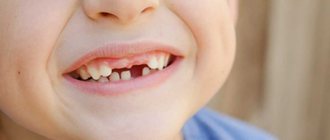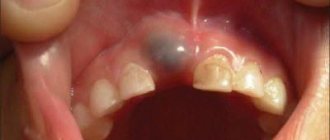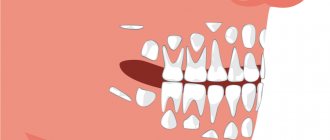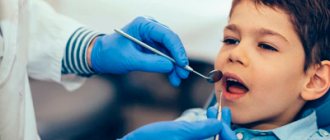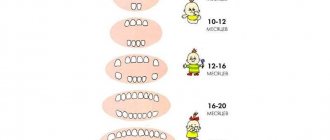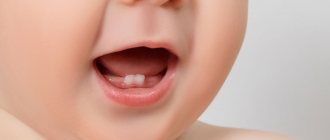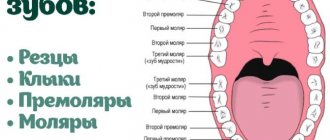Mom and dad can't wait for their child's baby teeth to begin to be replaced by molars. Such changes always raise a lot of questions. Usually molars grow without difficulty, but there is always a risk of complications. You can avoid possible unpleasant consequences if you regularly visit the pediatric dentist. The dental clinics of the Stomus network employ experienced and qualified specialists who can identify teething difficulties and help cope with them.
Content:
- Formation of permanent bite:
- Eruption of permanent teeth in children: timing and features:
- Features of care.
1.1. How does eruption occur?
2.1. Approximate timing of bite change. 2.2. Associated symptoms.
Until recently, dentists, like pediatricians, were quite strict about the time frame for the eruption of molars in children. In accordance with generally accepted standards, this process begins at 6 years and ends by 12–13 years. But as clinical data accumulates, experts are increasingly inclined to believe that such terms are quite arbitrary, that is, they are observed in most children, and deviations from the norm are not always a sign of a disease or some kind of developmental disorder.
When does a child's molars come out?
Growing permanent teeth is a big job for the body, which we rarely notice. Changes begin at 3 years - the rudiments of molars are formed. At age 5, noticeable gaps appear between the baby teeth to make room for new “tenants.”
Which teeth come out first is determined by a lottery - genetics. In half of the cases, growth begins with “sixes”. Molars grow by the age of 7-8 years, at the same time the front incisors change.
Teeth grow slowly but painlessly. At 14, the main bite is already formed. “Late” wisdom teeth - third molars grow in a few years, at 18-21 in most adults.
Formation of permanent bite
The development of molars in children begins in the prenatal period and lasts until 18–20 years, when their structure fully corresponds to “adult” parameters. That is why their condition, as well as the exact timing of eruption, depend on many factors. This:
- genetic predisposition, which is associated with metabolic characteristics;
- insufficient consumption of mineral elements in food, and we are talking about the nutrition of not only the child, but also the woman during pregnancy;
- fluoride deficiency in water and food;
- compliance with hygiene rules;
- some infectious diseases suffered by the mother (during gestation);
- insufficient functional activity of the salivary glands, since saliva contains certain substances that additionally provide mineralization of enamel, etc.
How does teething occur?
With the exception of rare cases of congenital or acquired pathologies, the appearance of molars coincides with the time of loss of milk teeth. Usually, part of the permanent tooth is already visible in this place; sometimes its growth is delayed for a short time, which is also one of the normal options.
Contrary to popular belief, temporary teeth have roots, and they differ in shape and structure from permanent ones: they can be curved and “sit” quite deeply in the gums. But as the child grows up and the rudiments of the molars grow, the “temporary” roots gradually dissolve and on an x-ray they look “eaten away”, shortened.
In this case, the pulp, where the nerve endings and blood vessels are concentrated, is replaced by granular tissue, which also participates in the resorption of the “milky” root system. And if depulpation (nerve removal) was previously performed due to injury or advanced caries, this process occurs faster.
Doctors' recommendations for painful teething
Dentists recommend paying more attention to the baby during this period and carefully maintaining hygiene, because the child strives to “test everything by heart.” You should also give him rubber teething rings chilled in the refrigerator, silicone toys, or special “teethers” with soft bristles. If the child does not have allergies, then you can give him a decoction of chamomile, valerian or sage. The dose should be checked with your pediatrician.
The dental network offers dental preventive services, including consultations on teething for children. Our specialists are highly qualified and improve their skills in leading Russian and foreign clinics. The pediatric dentist will conduct visual and hardware diagnostics and give recommendations on further actions. We have a system of family and cumulative discounts.
“Smile” branches are located in Moscow within walking distance from metro stations:
- Art. Alekseevskaya (VDNKh district, etc. Mira), address: st. 3rd Mytishchiskaya house 3, building 2;
- Art. Shelepikha, address: Shelepikhinskaya embankment, address: building 34, building 1.
Don't leave your children's dental problems to chance. Our doctors will provide effective, qualified assistance to you and your children. We are waiting for you every day without breaks and weekends.
Eruption of permanent teeth in children: timing and features
As a rule, this process begins at 5–6 years with the first molar. Frankly speaking, a panoramic X-ray of the jaw at this age looks somewhat unusual, since three rows are clearly visible on it: the first contains the milk teeth, the second contains individual molars at various stages of development, and the third contains the molars.
In most cases, by the age of 12–13 years, the replacement of the bite from temporary to permanent ends. But at the same time, the root system is not fully formed; usually this process lasts up to 15–16 years. In addition, within three years after eruption, intensive mineralization of the enamel occurs, then its rate changes depending on the influence of both external and endogenous (internal) factors. The content of mineral components is constantly increasing (subject to proper nutrition and oral care) and is considered “mature” only by the age of 18.
Approximate timing of bite change
It is not so easy for a non-specialist to decipher the dental formula, and if the difference between, for example, incisors and canines is obvious, then it is not always possible to understand molars and premolars. Therefore, for convenience, the dentition is designated by numbers from one to eight, starting from the central incisors to the left and, accordingly, to the right.
Like baby teeth, molars in children appear symmetrically in the following sequence:
- “ones” (central incisors): 6–8 years;
- “twos” (lateral incisors): approximately at 7 years old on the lower jaw and at 8–9 years old on the upper jaw;
- “threes” (fangs): at 10 years old from below and at 11–12 years old from above;
- “fours” and “fives” (first and second premolars, respectively): 10–12 years;
- “sixes” (first molars): 6–7 years, with root formation ending at best four years later;
- “sevens” (second molars): 11–13 years.
Special mention should be made about the eruption of “eights,” third molars, better known as “wisdom teeth.” The timing of their appearance varies. For some it is 19–20 years old, for others much later. There are cases when “eights” are completely absent. However, in such a situation, mandatory x-rays and consultation with a dentist are recommended. Sometimes they develop incorrectly, grow inside the gums, compress adjacent tissues, which leads to significant problems with the bite and, as a result, the aesthetics of the smile.
Associated symptoms
When the bite changes, the following are observed:
- Pain. Discomfort occurs as soon as a baby tooth begins to loosen. While eating, it is sometimes painful for a child to chew food, and discomfort also occurs when pressing on the gums in this area.
- Swelling and swelling , redness of the gums.
- Increase in body temperature up to 38–38.5°. As a rule, hyperthermia occurs during the eruption of molars.
- General malaise. Often a child, especially of preschool age, cannot talk about his feelings, so deterioration in health is accompanied by moodiness, lack of appetite, irritability, and tearfulness.
What signs are used to determine the appearance of molars?
There are several symptoms that, to a certain extent, may indicate that the child will soon have a permanent one in place of a baby tooth:
- The tooth is loose - this indicates that the root has begun to dissolve, as a result of which the fixation of the baby tooth has weakened.
- The tooth fell out - the reason for this is that the permanent tooth has already formed and pushed it out.
- A swelling appeared on the gum at the site of eruption.
- Body temperature has increased.
Take into account! The growth of permanent teeth leads to a weakening of children's immunity. Therefore, you need to give your child vitamins and take him to the dentist for preventative visits.
Features of care
A permanent bite requires careful care and attention. First of all, parents should teach their child the rules of hygiene:
- using a toothbrush twice a day (at least 3 minutes);
- if possible, rinse your mouth after eating, especially when it comes to sweets;
- using dental floss to clean the interdental space.
In addition, preventive visits to the dentist are mandatory. At an early age, the enamel is more susceptible to the influence of external factors, so caries progresses quickly. The pathological process can also affect the pulp (its size in a child is larger than in an adult), which will require long-term and painful treatment.
Particular attention should be paid to a balanced diet, active recreation, and walks in the fresh air. If you live in a region where the number of sunny days per year is small, you should discuss with your pediatrician the issue of using vitamin D and preparations containing calcium.
How many teeth change in children: order of eruption
During the replacement process, the child loses all twenty baby teeth, and 32 permanent teeth grow to replace them. Very often, the child first grows the first molars, which are absent in the primary dentition, and not the central incisors, as is commonly believed. In the future the sequence is as follows:
- lower, and behind them upper incisors in the center of the jaw;
- lateral incisors located above and below;
- 1st premolars;
- fangs;
- 2nd premolars;
- The 2nd and 3rd molars (“wisdom teeth” may never arrive).
It is not by chance that this sequence is laid down by nature. It takes into account the growth rate of the jaw and skull bones, which means that if the order is followed, the correct bite is formed.
First symptoms of teething
Many parents mistake drooling as a sure sign that their baby is teething. This is not so: at 3-4 months the salivary glands begin to work actively, but the baby does not have time to swallow saliva (the mechanism has not yet been developed). This process is not associated with tooth growth.
The only accurate first symptom of teething is redness on the gum and a white spot on it (the enamel begins to show through the thin skin). This can be quickly detected if you follow the rules of children's oral hygiene: wipe the baby's gums with a damp cloth several times a day. Also listen to the sensations during feeding: when the teeth approach the surface, they strongly compress the breast.
At the same time, the child begins to put everything in his mouth: the gums itch, preparing for teething. Due to inflammation of the gums, appetite disappears, pain in the ears and nose (these organs are closely related to the oral cavity), runny nose, and redness of the cheeks may appear.
Because of these symptoms, the baby becomes nervous: he sleeps poorly and has difficulty calming down. In the worst cases, when the inflammation is particularly severe, the temperature rises and the cheeks burn.
In this case, the situation can be alleviated by massaging the gums with Asepta finger napkins. They help disinfect the oral cavity, reduce swelling, and relieve itching in the teething area.
Please note: these symptoms are not necessary. In some cases, teething goes smoothly, calmly for the baby and parents. However, such cases are in the minority.
You may also be interested in
CHILDHOOD
Finger wipes from 0 to 3 years ASEPTA BABY
For gentle oral hygiene of babies and massage of gums during the eruption of the first teeth
More about the product
CHILDHOOD
Children's gel toothpaste from 0 to 3 years ASEPTA BABY
Designed for gentle care of baby's gums and baby teeth
More about the product
When do the first primary molars appear?
Molar teeth appear early in children. After a tubercle grows on the gum, little white spots appear. The milk molar organ appears between 1 and 2.5 years. They erupt painfully. By this time, the children’s chewing reflex has already developed. Children immediately use these chewing organs, because the consumption of solid foods without them was problematic. Tough food speeds up the process of jaw formation.
The deciduous bite contains eight molar units. Although the organs are located behind the fangs, they appear earlier from them. They come out in pairs. The chewing organ in the bottom row is shown first. Behind it appears a unit on the upper jaw. Second primary molars appear after 2 years of age. Sometimes it happens a little later or earlier. Dentists consider this normal. In order not to miss pathologies, if teething occurs later or earlier, it is worth showing the baby to a pediatrician and dentist. Deviation from the generally accepted pattern may be due to heredity or genetic predisposition.
The activity of the appearance of units increases by 24 months, that is, during the period of emergence of the second temporary chewing organs. The whole set appears by 30 months. Teeth replacement usually begins at age five and continues until age twelve. Molar units change the fastest. The order of replacement is the opposite of the pattern of appearance. Bone elements can grow in the free space that appears due to the fact that the jaw has grown. The first signs of loss of a time unit are swaying. You should wait until the rudiment falls out on its own. If it is removed, the permanent unit may appear in the wrong place, causing displacement of the masticatory organs.
Symptoms of appearance
Since the first molars are the largest rudiments, their chewing surface is extensive and their roots are large. Therefore, all mothers and fathers remember their birth, because they come out painfully. Only some babies do not experience discomfort. But this is a rare case. In other situations, many problems arise. Main symptoms:
- Rapid swelling of the gums.
- Increased salivation.
- The little ones become very restless.
- Sleep gets worse.
- Kids refuse to eat.
- Body temperature rises.
- If the body's defenses are reduced, a runny nose may appear.
- Sometimes babies suffer from diarrhea.
When tubercles with sharp edges sharply break through the gum tissue, babies suffer greatly from this. It happens that at the same time the growth of fangs begins. And these are the most painful sensations. The main symptom of the appearance of permanent units is the growth of the jaw, which entails the appearance of free spaces behind the temporary rudiments. At this point, permanent chewing organs will emerge. Gaps also appear between teeth. They ensure the even position of the indigenous bone organs.
To alleviate the condition of the little ones, pediatric dentists prescribe painkillers that will not cause harm to the body, and special rings for massaging the gums. A tasty syrup for toddlers is often recommended. When temporary rudiments change to permanent ones, the child needs to rinse his mouth. If the wound is bleeding, a soda solution will help. When severe swelling appears, the baby should be shown to the dentist. Dangerous complications can be avoided if you regularly visit the dentist and take good care of your oral cavity.
Features of molars
Large molars differ from other groups not only in external characteristics, but also have other features :
- these are the largest units in each dental arch;
- have the largest chewing surface;
- have a powerful root system;
- the upper molars are slightly larger than those on the lower jaw;
- have a stronger surface coating;
- able to withstand weight up to 75 kg;
- upper molars have 4-6 canals, while lower units generally have only 3 canals;
- maxillary molars have 3 roots (palatal, buccal-medial, buccal-distal), less often 4;
- the chewing teeth of the lower jaw have only 2 roots;
- wisdom teeth are the very last molars, which may appear by the age of 50 or not appear at all;
- the last molars are very often located not in the chewing arch, that is, they can grow horizontally or with a slight slope, located buccally or towards the tongue or palate;
- wisdom teeth have from 1 to 5 chewing cusps;
- the last molars often have a complex root configuration (curvature, fusion).
All this entails the peculiarities of treatment of such teeth. The presence of a large number of complex root canals, as well as difficult access compared to other groups of teeth, requires highly qualified doctors and modern equipment for high-quality therapy.
In dental practice, molars are considered the heaviest units, especially wisdom teeth. Proper care and regular preventive examinations will help keep them healthy. When the first signs of damage to the molars appear, we recommend that you immediately sign up for a consultation at our KAS+ dentistry. Timely detection of dental problems guarantees their high-quality treatment with minimal risk and long service life.
